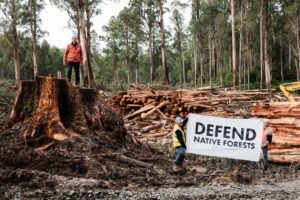 Back in 2020 I read an amazing book that I have constantly reflected upon: Wilding, by Isabella Tree. It was covid lockdown, and I was lucky enough to be spending it in the Swiss mountains. Every morning, rain or shine, I would do a hike through what I thought was a corner of Switzerland’s pristine forest. After reading Wilding, it hit me. I wasn’t hiking through forests, I was walking in a pine plantation. Let me explain to you why.
Back in 2020 I read an amazing book that I have constantly reflected upon: Wilding, by Isabella Tree. It was covid lockdown, and I was lucky enough to be spending it in the Swiss mountains. Every morning, rain or shine, I would do a hike through what I thought was a corner of Switzerland’s pristine forest. After reading Wilding, it hit me. I wasn’t hiking through forests, I was walking in a pine plantation. Let me explain to you why.
In the West the difference between a forest and a plantation isn’t taught in school. The fact that the UK was home to a temperate rainforest, has been conveniently forgotten, replaced by the idea of the English countryside being “beautiful” rolling moores. In Germany and Switzerland every tree is numbered by the government. Most rivers in Europe are channeled, the fact that salmon used to migrate up them to most sounds like a long-lost fantasy. European bison used to criss-cross the plains of Belgium and Germany, while beavers naturally dammed the rivers. Deforestation in Europe happened so long ago, that culturally we don’t even know what our primary forests looked like, which animals roamed and what plant medicines our ancestors foraged.
What I find even more troublesome, is what we interpret as “nature.” We can easily recognise agricultural land, but many still confuse a plantation for a forest. Right now, as wildfires ravage central and northern Portugal, experts are finally pointing the finger to Portugal’s paper and timber industries that dominate the area with eucalyptus and pine plantations. Did you know that eucalyptus is now the primary tree species in Portugal, despite being native to Australia?
“Eucalyptus covers 845,000 hectares in the Iberian countryside, or 26 percent of forests. Technically these are cultivations that feed the paper and cellulose sectors, with eucalyptus grown exclusively for pulp, which is used to make various paper products.”
Monocultures are highly flammable, you can imagine matchsticks being planted next to each other. This is why, when a fire starts, it can quickly spread across hectares and hectares of land, from one plantation to the other, creating monstrous human-made disasters.
In 2017, northern Portugal suffered similar wildfires in Pedrogrão Grande area, the fires killed 66 people and burned through 50,000 hectares of land. Many of the remaining pockets of native forests survived through those fires. Since then the local community has started to question the government’s plan to increase eucalyptus plantations, looking for an economic alternative to paper production in this rural area.
Just last week, seven firefighters lost their lives trying to quell the wildfires. When will justice prevail against the culprits of these disasters?
A local NGO, Quercus, that has been active in the area since 1985, is highly critical of the paper industry’s destruction of native flora, and has been working hard to restore and maintain what’s left of Portugal’s diverse biome.
“The pulp industry depends on eucalyptus plantations in this area. Together with the pressure on the government to expand eucalyptus acreage in Portugal, this means that there is no meaningful promotion of a diverse landscape that is more resilient to fires. When such landscapes are planted, or at least experimented with, it is in small areas near watercourses. There is nothing being done at scale to reduce the risk of fires.” says Domingos Patacho, director of Quercus.
We hope after this last two weeks where Portugal officially declared a state of calamity, the government will listen to Quercus’ pleas and finally support the regeneration of native forests and put an end to the paper domination of the Iberian coast.















